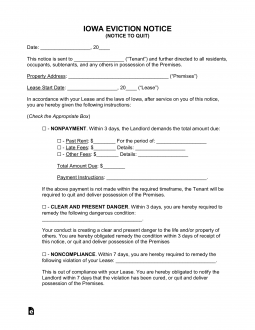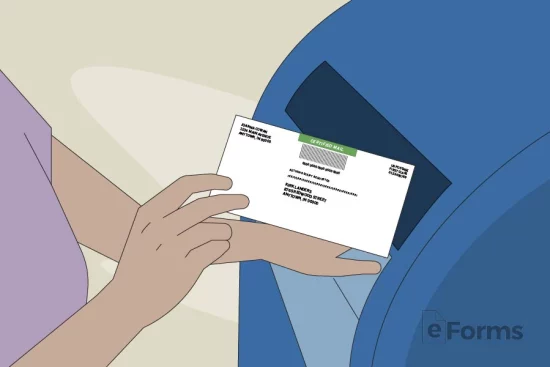Updated February 19, 2024
An Iowa eviction notice is a letter written by landlords to notify a tenant that they are in violation of their lease. The notice will include a detailed description of the offense and the required period to fix it. If the tenant does not correct the issue by the end of the notice period, the landlord will have the right to file an eviction lawsuit.
By Type (4)
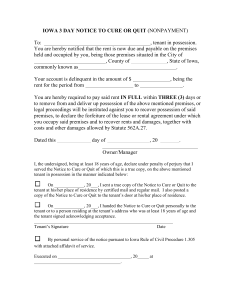 3-Day Notice to Quit (Non-Payment) – This form is used when a tenant has failed to pay rent. The landlord may give notice of the failure and must allow three days for the tenant to pay what is owed before commencing an eviction action. 3-Day Notice to Quit (Non-Payment) – This form is used when a tenant has failed to pay rent. The landlord may give notice of the failure and must allow three days for the tenant to pay what is owed before commencing an eviction action.
Download: PDF |
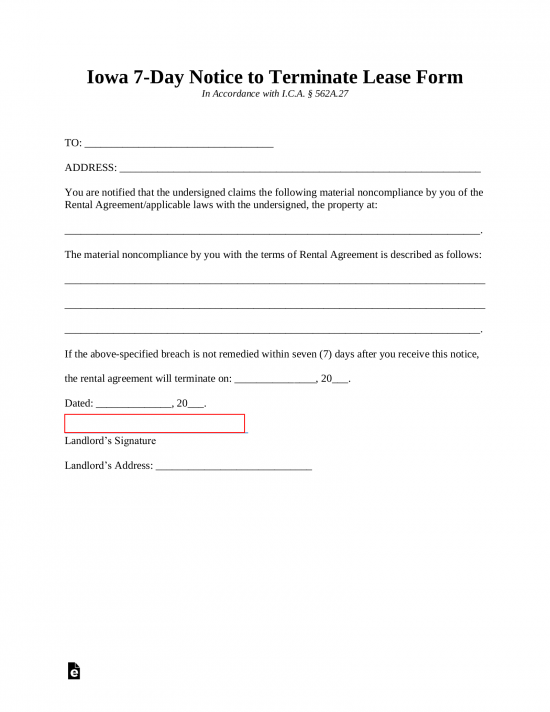 7-Day Notice to Quit (Non-Compliance) – This form is used when the tenant is in breach of the lease. Landlord must give the tenant seven days to fix the problem before commencing proceedings in court. 7-Day Notice to Quit (Non-Compliance) – This form is used when the tenant is in breach of the lease. Landlord must give the tenant seven days to fix the problem before commencing proceedings in court.
Download: PDF |
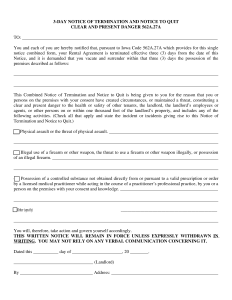 3-Day Notice to Quit (Clear and Present Danger) – This form is used when the tenant has engaged in dangerous conduct that puts people and property at risk. The landlord will have to prove evidence of such conduct when seeking eviction. 3-Day Notice to Quit (Clear and Present Danger) – This form is used when the tenant has engaged in dangerous conduct that puts people and property at risk. The landlord will have to prove evidence of such conduct when seeking eviction.
Download: PDF |
 30-Day Notice to Quit (Month-to-Month Tenancy) – This form is used when the landlord does not want to renew a month-to-month tenancy and wants the tenant to move out at the end of the month. 30-Day Notice to Quit (Month-to-Month Tenancy) – This form is used when the landlord does not want to renew a month-to-month tenancy and wants the tenant to move out at the end of the month.
Download: PDF, MS Word, OpenDocument |
Table of Contents |
Court Forms
Forcible Entry and Detainer Complaint – This document is used if the tenant has not responded to the notice to quit. It should be filed in the small claims court to begin the eviction process. It will then be served on the tenant to indicate that they are being sued.
Verification of Account – This document is used to relay the amount owed to the landlord, state whether the defendant is the military service, and to verify that the documents attached to the form and the calculations therein are accurate.
Appearance and Answer of Defendant – Used by the defendant to admit to, or deny the allegations made against them.
How to Evict a Tenant (4 steps)
1. Provide Notice to Tenant

First, the landlord must provide requisite notice to tenant of his or her intention to seek eviction proceedings if the tenant fails to vacate or rectify the specified problem. Tenant may not rectify a clear and present danger problem, or not agree to leave at the end of the term, however, tenant can rectify other breaches, including non-payment of rent.
The landlord should provide one of these notices to tenant, either by service of process, getting it signed by an adult at the residence, or by posting and mailing by certified mail:
2. File Forcible Entry and Detainer

If the tenant fails to respond satisfactorily to the written notice in the time allowed, the landlord may begin a forcible entry and detainer action in small claims court. In Iowa, the court system requires that small claims be filed electronically, so you will have to set up an account on the Iowa Judicial System’s eFiling site. You will then have to fill out this Forcible Entry and Detainer and file it electronically with the small claims court in your county. You will also need to file a confidential information sheet with the clerk.
The filing fee is $95.[6]
4. Attend Hearing

The court will set a hearing date within eight days of filing. You should have the evidence of serving the notice to quit as well as serving the forcible entry and detainer notice. The court will issue a decision either in favor of the landlord or tenant. If it is in favor of the landlord, the tenant shall have to vacate. If the tenant disagrees with the decision of the Judge, the tenant may file an appeal using a Notice of Appeal (form 3.26).

